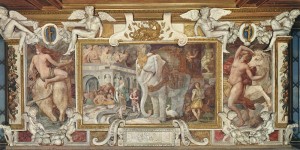The central fresco: c. 1.87 x c. 2.78 m.
Fig.P.22, VI N a whole wall
Fig.P.22, VI N b bw, whole wall
Fig.P.22, VI N c bw, Primaticcio & Rosso
Fig.P.22, VI N d Primaticcio & Rosso
PREPARATORY DRAWING: D.54A-F (COPIES). Berlin, Staatliche Kunstbibliothek, no. 3398 (Fig.D.54A); London (formerly), De Beer’s Fine Arts Ltd. (now Lord Methuen Collection?); New York, Wildenstein Collection (Fig.D.54C); Paris, Bibliothèque Nationale, B., 5 réserve, Drawings of the School of Fontainebleau, Vol. I, no. 31 (Fig.D.54D); Paris, Ensba, Masson 1197 (Fig.D.54E); Paris, Louvre, Inv. no. 1598 (Fig.D.54Fa), The Royal Elephant. All of these drawings in pen and ink and wash copy a single lost drawing by Rosso although some may be copies of a copy. The version in the Wildenstein Collection seems best to preserve the appearance of Rosso’s penmanship, and perhaps also of the washes of the lost original. The major difference between the drawing and the fresco is the appearance of the elephant. In the fresco its head is smaller, its ear shorter and more trim and its trunk curves towards its body and not away from it. The strap across the animal’s chest is changed in the painting and the bell has been removed. Its left foot is set farther back and hence the posture of the crane was changed. On the elephant’s cover the pattern of the fleur-de-lis has been altered and at the far right the heads of Cerberus were made slightly different. At the upper left the woman nude in the drawings is clothed in the painting. The copies also show that the nude figure at the upper right is Hercules with a lion skin over his head, his right hand on a club, and his left holding an orb; he is seated on a throne which has at its side a wingèd creature with lion’s feet.
PRINTS. E.65. Fantuzzi, The Royal Elephant (E.65). This etching, in the same direction as the fresco, appears in most respects to be dependent on Rosso’s lost drawing of which several copies are known (see above). All of the changes that do appear are found on the right side of the composition and some of them are related to the fact that Fantuzzi’s etching is narrower in the area to the right of the elephant. Hence, one large column is removed as well as the two figures next to it. Beneath the figure of Hercules the architecture has been somewhat elaborated. One of Cerberus’s heads has been changed more or less to repeat the one behind it. The lion’s head has been removed from the elephant’s covering and the parts of this covering have been fastened together differently with rosettes. Behind the elephant several buildings have been placed. The elephant’s bell is slightly changed, and the animal has been given hairy front legs. The only significant missing detail is Hercules’s club. It is very possible that Fantuzzi could not read this detail in the drawing although he does show the god’s hand cupped as though it were resting on his club. All of the differences in the etching are easliy attributable to the etcher.
E.9. Boyvin, The Rape of Europa (E.9). This engraving is related to the fresco at the left of this wall, and is in the same direction. However, the print shows the figure of Europa without the drapery that falls over her hip in the painting, and she has ribbons in her hair. Her right leg is somewhat lower in the engraving. The whole composition of the print is slightly broader than what appears in the gallery. The print is probably based on a lost drawing by Rosso the composition of which was slightly adjusted to the narrower wall area on which it was painted.
E.10. Boyvin, Saturn and Philyra (E.10). This engraving is related to the fresco at the right of this wall, and is in the same direction. The scythe is missing from the fresco. The print is probably based on a lost drawing by Rosso, the composition of which was slightly adjusted to the narrower wall area on which it was painted.
E.146. Anonymous, Saturn and Philyra (E.146). This bold etching is related to the fresco at the right of this wall, and is reversed. It more closely resembles the fresco than does Boyvin’s engraving. It is possible that the etching is based on another lost drawing by Rosso made later than the one that served Boyvin.

